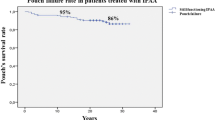Summary.
The ileoanal pouch procedure (IAPP) was the most remarkable breakthrough in the surgical therapy of ulcerative colitis (UC) and familial adenomatous polyposis (FAP) in the last 20 years. The underlying disease is under control, the function preserved and the quality of life markedly improved. Alternative procedures (terminal ileostomy, ileorectal anastomosis) are only indicated in special cases. In the last 16 years we have operated on 662 patients (n = 493 UC; n = 169 FAP) with an ileoanal J-pouch, short rectal cuff, complete mucosectomy and hand-sewn anastomosis. Normally there is a good function for UC and FAP patients after IAPP. Surgical experience, technical modifications concerning the pouch design and the pouch-anal anastomosis, and a differentiated indication lead to a further improvement of these complex procedures with consecutive reduction of complications. Specific complications concerned mainly the pouch-anal anastomosis (fistulas, abscesses, consecutive stenosis) and inflammation of the pouch mucosa (pouchitis). A multivariate analysis showed, that increasing experience of the specialized center is a significant factor reducing inflammatory problems at the anastomosis. The cumulative incidence of pouchitis was 29 %. In general there is no problem in successful treatment. But patients with chronic pouchitis are a problematic group (6.2 %). Chronic pouchitis is difficult to treat. It is likely that there exists an inflammation dysplasia carcinoma sequence for the ileal pouch mucosa, analogous to the colorectum. Recently we diagnosed the first case of a real ileum pouch carcinoma with associated epithelial dysplasias following chronic pouchitis. Therefore patients with chronic pouchitis must be followed up by endoscopy and random biopsies in a surveillance program. Patients with UC and FAP can gain the life quality of healthy controls, if postoperative complications can be avoided or treated successfully. For the further development of the procedure and the individual long-term success a qualified follow-up and therapy of complications is essential. Both can be carried out only by a specialized center.
Zusammenfassung.
Durch die ileoanale Pouchoperation (IAP) gelang in den letzten beiden Dekaden der entscheidende Durchbruch in der chirurgischen Therapie der Colitis ulcerosa (CU) und der familiären adenomatösen Polyposis (FAP). Die Grunderkrankung ist beherrscht, die Funktion erhalten und die Lebensqualität deutlich verbessert. Alternative Verfahren (terminale Ileostomie, ileorectale Anastomose) sind nur noch Sonderindikationen vorbehalten. In den letzten 16 Jahren versorgten wir 662 Patienten (n = 492 CU; n = 169 FAP) mit einem gestapelten ileoanalen J-Pouch, kurzem Rectum-Cuff, kompletter Mucosektomie und handgenähter Anastomose. Durch die IAP läßt sich für Patienten mit CU und FAP in der Regel eine gute Funktion erreichen. Chirurgische Erfahrung, technische Modifikationen im Pouchdesign und im Bereich der Anastomose sowie eine differenzierte Indikationsstellung führten zu einer steten Optimierung dieses komplexen Operationsverfahrens mit konsekutiver Reduktion postoperativer Komplikationen. Spezifische Komplikationen betrafen in erster Linie die Anastomose (Fisteln, Abscesse, konsekutive Stenosen) und entzündliche Veränderungen der Reservoirmucosa (Pouchitis). In einer multivariaten Analyse konnte gezeigt werden, daß die zunehmende Erfahrung des Zentrums ein signifikanter Faktor zur Reduktion entzündlicher Anastomosenprobleme ist. Die kumulative Incidenz der Pouchitis betrug 29 %. Sie war in den meisten Fällen unproblematisch zu behandeln. Eine problematische Gruppe stellen jedoch Patienten mit einer chronischen Pouchitis dar (6,2 %). Die chronische Pouchitis ist kaum therapeutisch zu beeinflussen. Wahrscheinlich besteht für die Ileumpouchmucosa, analog zum Colorectum eine Entzündungs-Dysplasie-Carcinom-Sequenz. Patienten mit chronischer Pouchitis müssen deshalb lebenslang endoskopisch-bioptisch nachgesorgt werden. Sowohl für CU- als auch für FAP-Patienten kann nach IAP eine Lebensqualität erzielt werden, die einer gesunden Kontrollgruppe entspricht, wenn postoperative Komplikationen vermieden oder im weiteren Verlauf beherrscht werden. Essentiell für die Weiterentwicklung des Verfahrens und den individuellen Langzeiterfolg nach IAP ist deshalb eine qualifizierte Nachsorge und eine adäquate Therapie von Komplikationen. Beides kann nur von spezialisierten Zentren geleistet werden.
Similar content being viewed by others
Author information
Authors and Affiliations
Rights and permissions
About this article
Cite this article
Heuschen, U., Heuschen, G. & Herfarth, C. Der ileoanale Pouch als Rectumersatz. Chirurg 70, 530–542 (1999). https://doi.org/10.1007/s001040050684
Issue Date:
DOI: https://doi.org/10.1007/s001040050684




